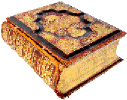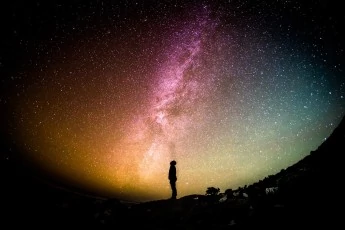Before internet and television were around, people actually sat around and observed things. They observed the night sky. They observed the twinkling stars, night after night after night. How comforting it must have been for them to see the same constellation in the sky every night. And then one night… “wait a minute…where did that reddish star go? It’s not in the same spot anymore! This is strange.” And that was an amazing scientific breakthrough for the ancient world.
It was finally observed that there were five wandering “stars,” plus the moon and sun, making for a total of seven wandering rascals. Now, what they called wandering stars, we call planets. The luminaries (sun & moon) were included because they were observed in different portions of the sky, and thus they “traveled” along with the other rascals.
Once they noticed those seven amazing wandering celestial bodies, the ancient world never took its eyes off of them. Those seven were EVERYTHING. People watched the celestial bodies travel on their heavenly path, year after year. To keep track of their positions, they separated the heavenly path (the ecliptic) into 12 equal sections. These 12 sections became the zodiac signs. The zodiac signs are not star constellations, as you’ll read below.
Please note here that the wheel of zodiac signs was carefully and mathematically calculated. We’re talking about ancient geniuses, here. The wheel of zodiac signs was created by first splitting our sky into four sections designated by the yearly equinoxes and solstices (the turning points of the four yearly seasons). Each of these four sections of sky were split into 3 sections measuring 30 degrees each. This gives us a full 360-degree zodiac circle with 12 equal sections of 30 degrees each. Each 30-degree section is one zodiac sign, for a total of 12 zodiac signs (12, not 13). These 12 zodiac signs are not star constellations. They are 30-degree sections of space that were mathematically calculated in a way that was, and still is, intimately connected to our yearly seasons.
Since as early as the 2nd century BCE in ancient Greece, the zodiac circle has always assigned zero degrees of Aries (Aries, the zodiac sign, not the star constellation) to the Vernal Equinox (the Spring Equinox, or the first day of Spring in the northern hemisphere). This zodiac wheel, also known as the tropical zodiac, is still in use today. This wheel is still accurate because we always align/begin it, as the ancients Greeks did, with the first day of Spring. This not a mistake. The zodiac wheel is intimately aligned with our Earth’s seasons. (This is an important fact to recognize. Some people today fail to recognize this fact, and so they erroneously claim that the zodiac wheel is misaligned.)
The ancient Babylonians (as early as the 5th century BCE) documented the positions of the wandering planets, using the constellations as markers in the sky. As a handy convenience, and also likely out of necessity, they used the star constellations that appeared in the general area of each zodiac sign as markers. They designated 12 constellations to represent the 12 zodiac signs in the sky. The star constellations, with their varying degrees and sizes, are not the actual zodiac signs. These constellations were named after the zodiac signs they represent, not the other way around!
By using the constellations as markers in the sky, they could easily track each planet’s path as being in one zodiac sign or another. This could easily have been done just by looking up into the sky at the constellations – so easy, a caveman could’ve done it. Those five classical planets are visible to the naked eye. (Mercury, Venus, Mars, Jupiter, and Saturn are visible without a telescope.)
Remember, this was before internet and television. The night sky was their movie theater. Every time anything happened, they took note of the positions of the planets. When a baby was born, the positions of the planets at that moment were noted. Ten babies were born, their planets were noted. A hundred babies were born, their planets were all noted. The babies grew up. Maybe one became wealthy, maybe one was loud and obnoxious, maybe one was quiet and humble, maybe one was a compulsive liar, maybe one was a daydreamer, and maybe one was crucified and started a new religion. In each case, the birth planets were remembered. The information was passed around and passed down. These observations continued and grew exponentially as population size grew. So, when all the dreamers just so happened to be born when Mercury was in Pisces, it became safe to say that the next baby born with Mercury in Pisces will be a dreamer. (This is only an example for illustrative purposes.)
But that is only a very simplistic example. As time passed, they fine-tuned their observations. The observations were then based on exact mathematical calculations for all seven celestial bodies. In fact, math logarithms were developed precisely for the purpose of calculating horoscopes (charts). In other words, it wasn’t simply a planet’s position that denoted something about a person’s character. It was the configuration of all seven celestial bodies as a whole that really said something. You see, the planets are always moving, making different angles to each other. This means that no two people have the same planetary configurations; your horoscope is as unique as your fingerprint. Hence the occasional Mercury-in-Pisces person who is not a dreamer. And thus, the horoscope (a map of the heavens for a specific time) came to be the center of Astrology. (Your horoscope is your birth chart, NOT those silly daily positive quotes from flaky sources that don’t even know your birth time. Horoscopes are calculated with mathematical accuracy.)
Thousands of years later, astrology still stands as the most powerful tool for exposing our psychological makeup. But most people denounce it as a silly superstition because they find it hard to believe that the physical, material world can say anything about what goes on in a human mind. Sure, they believe that the material world can show when it’s about to rain, when the ocean’s tides (as pulled by the moon) go high and low, and when a tropical storm will grow into a hurricane. But these people seem to think that our feeble, little human bodies are somehow immune to the ebb and flow of energy across the universe. Oh, please.
We don’t know why, we don’t know how, but we astrologers know that our solar system is like a cosmic clock (or mirror?) that reveals amazingly accurate details based on the moment you took your first breath in this world. What were the positions of the planets at your birth time? See what astrology says about it before you dismiss it as “just a superstition.” Astrology’s precision for thousands of years has been like clockwork.
 AstroLibrary 🔎
AstroLibrary 🔎

Chris
I love the quote “…and maybe one was crucified and started a new religion”. Genius and witty!
France Duffoó
I loved that too, very much.
Leon
I love the part when you say….” But these
people seem to think that our feeble, little human bodies are
somehow immune to the ebb and flow of energy across the
universe. Oh, please.”
i love your passion and belief in astrology and i wish i could have been knowledgeable as you on astrology.
Raphael Coleman
very awesome, we should rather learn in school instead of religion
gordon
I was wondering if the time of conception would be relevent? If it could be known.
S.
the more details you have, the more detailed the information you get.
Nishu njstar
Thanks for letting the world know the truth